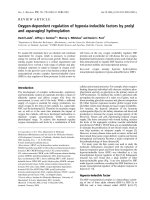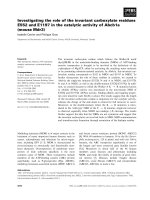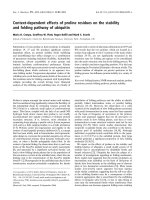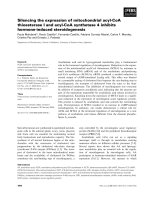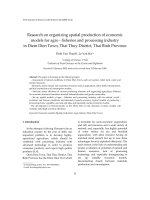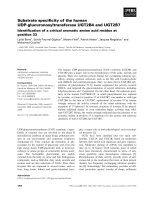Báo cáo thú y: ": Cases with manifestation of chemodectoma diagnosed in dogs in Department of Internal Diseases with Horses, Dogs and Cats Clinic, Veterinary Medicine Faculty, University of Environmental and Life Sciences, Wroclaw, Poland" docx
Bạn đang xem bản rút gọn của tài liệu. Xem và tải ngay bản đầy đủ của tài liệu tại đây (1.13 MB, 7 trang )
Noszczyk-Nowak et al. Acta Veterinaria Scandinavica 2010, 52:35
/>Open Access
CASE STUDY
BioMed Central
© 2010 Noszczyk-Nowak et al; licensee BioMed Central Ltd. This is an Open Access article distributed under the terms of the Creative
Commons Attribution License ( which permits unrestricted use, distribution, and repro-
duction in any medium, provided the original work is properly cited.
Case study
Cases with manifestation of
chemodectoma
diagnosed in dogs in Department of Internal
Diseases with Horses, Dogs and Cats Clinic,
Veterinary Medicine Faculty, University of
Environmental and Life Sciences, Wroclaw, Poland
Agnieszka Noszczyk-Nowak*
1
, Marcin Nowak
2
, Urszula Paslawska
1
, Wojciech Atamaniuk
3
and Jozef Nicpon
Abstract
In the period of 3 years, 9 tumours of chemodectoma were supravitally diagnosed and histopathologically verified in
dogs. In this period 15 351 dogs were admitted to the Clinic of Dogs and Cats and 2 145 dogs were examined in the
cardiological outpatient clinic for dogs. This tumour is located in a typical place - at the base of the heart. Most
frequently the tumour manifested in older boxers. Only in one case such a tumour was diagnosed in another breed of
dogs. The tumours ranged in size between 3 and 16 cm in diameter. The principal sign accompanying tumours of
cardiac base involved dyspnoea but in 3 cases the tumours yielded no clinical signs. All the diagnoses were additionally
verified using immunohistochemical examination. We used antibodies to chromogranin A (clone DAK-A3 1:100),
synaptophysin (clone SY38 1:20) and neuron-specific enolase (clone BBS/NC/VI-H14 1:150). An immunohistochemical
examination is vital for the diagnosis since it allows to differentiate histologically distinct types of neoplasia which may
locate in the same site and may manifest a similar histological pattern.
Introduction
Chemodectomas s. paragangliomas represent tumours
derived from chemoreceptor cells originating most fre-
quently from aortic body or carotid glomus [1]. The site
of their origin may involve also the tympanic cavity and
inferior vagal ganglion. In animals the tumours manifest
most frequently in the form of a single tumour located at
the base of the heart. Less frequently they form accumu-
lation of small tumours. Occasionally, they infiltrate myo-
cardium [2]. Chemodectoma may manifest traits of a
malignant tumour or of a benign tumour [1,3]. It should
be added that in most cases chemodectoma metastases
are infrequently encountered [4]. Tumour neuroendo-
crine cells (type I cells) may produce and secrete cate-
cholamines and serotonin [5,6]. The authors described
secretory granules in chemodectoma tumour cells, even if
DJ Meutena is his book Tumours claims that in animals
chemodectomas do not produce catecholamins [7]. Cate-
cholamines may induce disturbances in the cardiac
rhythm, not infrequently associated with chemodectoma
[8]. Diagnosis and treatment of cardiac tumours continue
to be difficult. The diagnosis takes advantage of the most
modern imaging techniques, i.e., ultrasonography, radi-
ography and magnetic resonance [3,9]. Their accurate
diagnosis, however, apart from standard staining with
hematoxylin and eosin requires application of immuno-
histochemistry with use of antibodies specific for chro-
mogranin A, synaptophysin and neuron-specific enolase
[1,10-13].
The present study aimed at analysis of manifestation
and characteristics of chemodectoma type cardiac base
tumours.
Materials and methods
The studies were performed on 9 dogs, patients of the
Department of Internal Diseases with Horses, Dogs and
* Correspondence:
1
Department of Internal Diseases with Horses, Dogs and Cats Clinic, Veterinary
Medicine Faculty, University of Environmental and Life Sciences Wroclaw 50-
366, Poland
Full list of author information is available at the end of the article
Noszczyk-Nowak et al. Acta Veterinaria Scandinavica 2010, 52:35
/>Page 2 of 7
Cats Clinic, and the Department and Clinic of Surgery,
Veterinary Medicine Faculty, University of Environmen-
tal and Life Sciences. In 6 dogs the reason for the consul-
tation of veterinary doctor was a pronounced dyspnoea.
In 2 dogs the tumour of the cardiac base was diagnosed
during cardiological examination, performed before sur-
gical procedure. In one dog the tumour was detected dur-
ing radiological examination of the chest, performed due
to suspected fracture of the ribs following a traffic acci-
dent. In all the dogs morphology and biochemistry of
venous blood was carried out, gasometric tests on arterial
blood, echocardiography of the heart, chest X-ray and
ECG examination were performed. All the dogs were
subjected to euthanasia in the period ranging from 3 days
to 18 months following the diagnosis of the cardiac base
tumour. During autopsy, samples of the tumour, myocar-
dium of the right and the left atrium, the right and the left
ventricle, intraventricular septum, lungs, liver and kid-
neys were taken and fixed in a buffered 7% solution of
formalin. Staining with hematoxylin and eosin was per-
formed and, then, immunohistochemical studies were
conducted with the use of antibodies to chromogranin A,
synaptophysin and neuron-specific enolase (NSE). The
sections were mounted on Superfrost slides (Menzel
Gläser, Germany), dewaxed with xylene and gradually
rehydrated. Activity of endogenous peroxidase was inhib-
ited by 5 min exposure to 3% H
2
O
2
. Detection of chro-
mogranin A, synaptophysin and neuron-specific enolase
antigen expression was preceded by 15 min exposure of
the sections in a microwave oven to a boiling Antigen
Retrieval Solution (DakoCytomation, Denmark) at 250
W. For demonstration of chromogranin A, synaptophysin
and neuron-specific enolase antigen expression in the
paraffin sections, antibodies were used in the following
concentrations: clone DAK-A3 (1:100) (DakoCytomation,
Denmark); clone SY38 (1:20) (DakoCytomation, Den-
mark); clone BBS/NC/VI-H14 (1:150) (DakoCytomation,
Denmark). The antibodies were diluted in the Antibody
Diluent, Background Reducing solution (DakoCytoma-
tion, Denmark). The sections were incubated with an
antibody for 1 h at room temperature. Subsequently,
incubations were performed with biotinylated antibodies
(15 min, room temperature) and with streptavidin-bioti-
nylated peroxidase complex (15 min, room temperature)
(LSAB2, HRP, DakoCytomation, Denmark). DAB (Dako-
Cytomation, Denmark) was used as a chromogen (7 min,
room temperature). All the sections were counterstained
with Meyer's hematoxylin. In every case controls were
included, in which specific antibody was substituted by
the Primary Negative Control (DakoCytomation, Den-
mark).
Depending on the value of proliferation index, cell mor-
phology, possible infiltration into interior of vascular wall
or myocardium as well as presence or absence of metasta-
ses the tumours could be categorized to three grades of
malignancy: I (benign) - low proliferation index (up to 2
mitotic figures per 1000 cells), relatively uniform cells, no
infiltration of the neighbourhood and no metastases, II
(malignant) - low to average proliferation index (2 to 10
mitotic figures), less uniform cells, presence of tumour
regions with infiltrative growth, possible presence of
metastases, III (malignant) - high proliferative index
(more than 10 mitotic figures), evident cellular pleomor-
phism, infiltrative growth, presence of metastases [1].
Macroscopically, benign tumours demonstrate absence of
necrotic foci or haemorrhages. In most of benign hyper-
plasias cells were of a similar size and shape and hyper-
chromasia was infrequently encountered.
Results
Dogs in which the tumour of the cardiac base was diag-
nosed, were between 8 and 13 years old (mean 9.7 1.8)
(Table 1). The group included 5 male and 4 female dogs.
Among the male dogs one was subjected to castration 3
years before diagnosis of the tumour of the cardiac base.
Among the female dogs two were subjected to ovario-
hysterectomy 5 to 7 years before diagnosis of the cardiac
base tumour. Among the studied dogs, boxers prevailed
(8 dogs), only one represented another breed (a dachs-
hund). The tumours of the cardiac base in all the cases
could be detected by chest X-ray (Figs. 1 and 2), in 6 cases
they were also detected by echocardiography (Fig. 3).
Blood morphology and biochemistry (WBC, RBC, PLT,
Hb, Ht, urea, creatinine, ALT, AST, FA, K
+
, Na
+
, Ca
2+
)
detected no abnormalities although deviations were
noted by gasometry (Table 2). Among the signs, dyspnoea
and fatigability prevailed. In 5 out of the 9 dogs a
hydrothorax and in 2 a hydropericardium were noted. In
all 5 dogs with hydrothorax and in 2 dogs with hydroperi-
cardium the fluid contained no atypical cells. In 5 out of
the 9 dogs resting ECG examination detected numerous
precocious, single and paired ventricular beats. In one
dog an attack of ventricular tachycardia was detected.
The tumours ranged from 3 cm to 16 cm in diameter (Fig.
4), they manifested a firm consistency, mosaic colour and
each was surrounded by a connective tissue capsule. All
the tumours manifested a junction with the aortic arch,
noted even in the ultrasonographic examination (Fig. 3).
Tumours exceeding 8 cm in diameter contained foci of
necrosis and haemorrhages (Fig. 5). In a single case the
tumour contained several cavities. In all the cases the
tumour was verified to represent chemodectoma. In 4
cases neoplastic cells infiltrated a blood vessel and/or the
cardiac atrium. In none of the cases could metastases to
other inner organs be detected. In all 9 cases of the car-
diac base tumours histopathological examination
detected neoplastic hyperplasia of chemodectoma, in its
either benign (5 cases) or malignant (4 cases) form (Table
Noszczyk-Nowak et al. Acta Veterinaria Scandinavica 2010, 52:35
/>Page 3 of 7
Table 1: Tumour size and its manifestation in laboratory tests
Case No Breed Sex Age (years) Tumour
diameter
Radiological
examination
USG Grade of
malignancy
ECG
1 boxer M 13 16.0 cm detectable detectable III Numerous, individual or paired
premature ventricular beats
2 boxer F 8 9.0 cm detectable detectable II Numerous, individual premature
ventricular beats
3 boxer F 11.5 4.0 cm detectable not
detectable
Benign Ventricular tachycardia
4 boxer M 11 7.0 cm detectable detectable II Numerous, individual premature
ventricular beats
5 boxer M 9 4.5 cm detectable not
detectable
II Numerous, individual premature
ventricular beats
6 boxer M 10 11.0 cm detectable detectable Benign Numerous, individual or paired
premature ventricular beats
7 boxer F 8.5 3 cm detectable not
detectable
Benign No arrhythmia
8 boxer M 8 5 cm detectable detectable Benign No arrhythmia
9dachsh
und
F 8 5 cm, detectable detectable Benign No arrhythmia
1). The tumour cells formed numerous foci of a variable
size, separated by trabeculae of connective tissue, well
supplied with blood. Most tumour cells manifested a
polygonal outline, a spherical or oval cell nucleus and
individual nucleoli. In contrast to benign forms, the cases
of malignant forms demonstrated locally numerous, fre-
quently abnormal mitotic figures. The cytoplasm was
finely granular with numerous vacuoles of various shape
and size. The characteristic trait of malignant forms was
an extensive polymorphism of cell nuclei and their hyper-
chromasia (Fig. 6). Moreover, a rich blood supply was evi-
dent, with numerous muscular arterioles, thin-walled
veins and a network of fine capillaries within the connec-
tive tissue septa. In some regions of the tumours cells
formed a radial pattern around blood vessels. The micro-
scope examination of the malignant forms demonstrated
also dispersed areas of haemorrhages and an extensive
necrotic region in the tumour centre (Fig. 5). The periph-
eral part of the tumours contained fine, mainly lympho-
histiocytic inflammatory infiltrates.
In order to verify the results of the standard histopatho-
logical examination with hematoxylin-eosin staining,
immunohistochemistry was applied with use of a panel of
antibodies, specific for tumour cells of neuronal or neu-
roendocrine origin [12-14]. All the antibodies yielded a
positive reaction with a fine granular, brownish reaction,
localized mainly in the cytoplasm of the tumour cells (Fig.
7, 8 and 9), which confirmed the preliminary diagnosis.
Negative control demonstrated no colour reaction, thus
confirming that the procedure was properly conducted.
Discussion
Tumours of the cardiac base usually develop in older ani-
mals [1,15]. In the studied group of dogs the main age was
to 9.8 ± 1.8 years. A breed particularly predisposed to
such tumours involves boxers, which in our group
accounted for 9/10 (89%) of the affected dogs [9]. In the
years 2006-2008, 167 dogs of the boxer breed were exam-
ined. In that group a cardiac disease with arrhythmias
was diagnosed in 71 boxers and a chemodectoma was
confirmed in 9 dogs, accounting for 5.4% of the examined
population and for 12.7% of the examined dogs with car-
diac disease. A single dog with the diagnosed tumour of
the cardiac base of chemodectoma has represented
another breed (a dachshund). In the years 2006-2008,
1472 dogs of the dachshund breed were examined in our
Noszczyk-Nowak et al. Acta Veterinaria Scandinavica 2010, 52:35
/>Page 4 of 7
clinic, in that group 617 dachschunds manifested cardiac
disease (571 dogs suffered from heart failure, 46 mani-
fested arrhythmias). In this time, among other animals,
896 German Sheppard Dogs, 267 Dobermans, 594 York-
shire Terriers were consulted in the clinic. They are the
most popular breeds in Poland. Manifestation of tumours
of this type in boxers may be linked to the type of struc-
ture in the upper respiratory tract (brachycephalic airway
syndrome -BAS). The primary features of BAS include
stenotic nares, an elongated soft palate, and distortion of
the pharyngeal soft tissues due to restral shortening of
the skull. These abnormalities are seen in brachycephalic
breeds and they increase resistance to airflow in the
upper respiratory tract. The increased negative pressure
required during inspiration may result in secondary
changes including laryngeal collapse. These abnormali-
ties cause the chronic hypoxia and are suspected to pro-
vide a cause of hyperplasia and, finally, neoplasia of
chemoreceptor cells [1,6]. In 1969, Arias-Stella reported
enlargement of the carotid bodies in high-altitude dwell-
ers in the Peruvian Andes. The carotid bodies of guinea
pigs, rabbits and dogs which had been born and lived all
their lives in Peru (altitude of 4330 meters) were found to
be enlarged. Climate can influence the development of
neoplasms. Peruvian adults born and living at high alti-
tude in the Andes have high incidence of chemodectoma.
It is related to chronic hypoxia. In cattle living at high alti-
tude Ariss-Stella and Valcarcel observed carotid bodies
with extreme chief cell hyperplasia and the chemodec-
toma was present in 40% of the animals [5]. The assumed
relationship seems to be confirmed by the results of gaso-
metric tests on arterial blood, which have clearly demon-
strated a lower partial pressure of oxygen, increased
partial pressure of carbon dioxide, decreased base excess
(BE) and normal pH. It is a pattern typical of compen-
sated respiratory acidosis. The respiratory acidosis may
develop in boxers due to their structural type of the respi-
ratory tract, representing part of the so-called brachyce-
phalic syndrome. Large size tumours of the cardiac base
obviously may induce respiratory disturbances leading to
acidosis but in our study respiratory acidosis developed
also in dogs with small tumours (3-4.5 cm). Such small
tumours are not able to compress bronchi and cannot
mechanically interfere with gas exchange. These observa-
tions might indicate that respiratory acidosis represents
the primary disturbance and that it might predispose
dogs of the boxer breed to development of chemodec-
toma. In the dog of the dachshund breed a probable cause
of poor gas exchange involved nasal polyps. It should be
added that in other brachycephalic breeds, such as, e.g.,
Pekinese the tumour does not develop more frequently
than in general population of dogs but an increased inci-
dence of the tumour was described in Boston terriers
and, thus, a family predisposition to development of
chemodectoma is possible [6]. Among the signs, dyspnoea
dominated, affecting 6/9 (67%) of the dogs. It resulted
from hydrothorax and pressure exerted by the large
tumours on the main bronchi. In one of the dogs
hydrothorax was accompanied by hydropericardium. In
the other case, hydropericardium represented the only
sign of the cardiac base tumour. The heart base tumours
could always be detected in the radiological examination
of the chest, in the lateral and dorso-ventral projection.
The ultrasonographic examination of the heart detected
only the tumours which exceeded 4.5 cm in diameter. In
view of the obtained results, the radiological examination
has proven more sensitive in detection of cardiac base
tumours than the ultrasonographic examinations. Differ-
ential diagnoses should comprise metastasis, mediastinal
abscess, lymph node inflammation in mediastinum, lym-
Table 2: Results of blood tests
Case No 1 2 3 4 5 6 7 8 9 Standard
Breed boxer boxer boxer boxer boxer boxer boxer boxer dachshund
Sex MFFMMMFMF
age [years] 13811.5119108.58.08
pH 7.43 7.37 7.38 7.36 7.37 7.36 7.39 7.36 7.37 7.35-7.45
pCO2 [mmHg] 45 50 48 49 48 49 51 51 49 35-45
pO2 [mmHg] 62 46 62 40 46 48 50 42 46 85-100
BE [mmol/l] -2.1 -2.8 -2.6 -2,8 -2.1 -2.4 -2.5 -2.1 -2.2 2 - (-2.0)
Noszczyk-Nowak et al. Acta Veterinaria Scandinavica 2010, 52:35
/>Page 5 of 7
phoma. Metastases were excluded in post-mortem exam-
ination, mediastinal abscess, inflammation of lymph
nodes and lymphoma were excluded by morphological
and biochemical examination of blood. Type I (neuroen-
docrine) cells of chemodectoma contain secretory gran-
ules with catecholamines which may induce ventricular
arrhythmias. In the studied dogs with chemodectoma
numerous premature ventricular beats were detected.
One dog manifested attacks of ventricular tachycardia,
which disappeared following intravenous administration
of a beta-blocker but did not vanish following administra-
tion of lidocaine, which is the drug of choice. This might
Figure 1 Radiogram of chest in right-left lateral projection. Pres-
ence of the large tumour in mediastinum elevated trachea in dorsal di-
rection (black arrows). Outline of the tumour remains invisible since its
shadow overlaps with that of the other mediastinal organs, including
the heart. Case no 2.
Figure 2 Radiogram of chest in ventro-dorsal projection. The ven-
tro-dorsal projection of the chest visualizes well the left and the right
edge of the tumour. The widest dimension of the tumour amounts to
around 8.4 cm. Note the transplaced to the right trachea (T). The ap-
proximate length amounts to 10.3 cm. Case no 2.
Figure 3 Echocardiography image in apical projection. Tumour of
heart base seen near the aorta. Case no 4.
Figure 4 Autopsy. Tumour of heart base. Case no 1.
Noszczyk-Nowak et al. Acta Veterinaria Scandinavica 2010, 52:35
/>Page 6 of 7
be interpreted as consistent with the potential for pro-
duction of catecholamines by chemodectoma tumours.
The described location of the tumour might predispose
to supraventricular arrhythmias which, however, were
not recorded in the examined dogs. Blumcke et al exam-
ined reaction of carotid bodies in rats to acute and severe
oxygen deficiency. They detected the almost total dis-
charge of catecholamines from type I cells after 20 min-
utes of extreme hypoxia, which was confirmed by
fluorescence microscopy. Mitchell postulated that cate-
cholamines in the type I cells may function as transmit-
ters in an efferent neuronal pathway. Chemodectoma
represents a tumour which usually does not metastasize.
Nevertheless, some cases of metastases were described -
to lungs, liver, myocardium and even to brain and bones
[1]. In all the cases the tumour was verified to represent
chemodectoma; five benign and four malignant cases. In
malignant cases neoplastic cells infiltrated a blood vessel
and/or cardiac atrium with no metastases to other
organs.
Out of all the applied markers, used to detect neoplastic
cells of neuronal or neuroendocrine origin, the highest
significance was linked to chromogranin A. The protein,
as a protein prohormone, represents a marker of neu-
roendocrine differentiation and the directed against it
antibodies are used to identify cells and tumours of neu-
roendocrine origin. Expression of NSE and that of synap-
tophysine manifested a similar level in the cells of both
benign and malignant tumours. On the other hand, in the
case of chromogranin A we, similarly to Aresu et al. [1],
have found that expression of the marker decreases with
increasing malignancy of the tumour.
Our observations have shown that all the applied anti-
bodies are useful in differential diagnosis of neoplastic
Figure 5 Micrographs. It showing dispersed foci of haemorrhage
(long arrow) and extensive region of necrosis in centre of the tumour
(short arrow) in malignant forms of the tumour.
Figure 6 Micrographs. It showing extensive polymorphism of cell nu-
clei (arrows) and their hyperchromasia in malignant cells of the tu-
mour.
Figure 7 Expression of chromogranin A in cytoplasm of chemod-
ectoma cells.
Figure 8 Expression of synaptophysin in cytoplasm of chemodec-
toma cells.
Noszczyk-Nowak et al. Acta Veterinaria Scandinavica 2010, 52:35
/>Page 7 of 7
processes located at the cardiac base but only chromogra-
nin A may help in evaluation of tumour malignancy.
Summing up, chemodectoma develops in dogs of the
boxer breed significantly more frequently than in the gen-
eral population of dogs. As demonstrated by our observa-
tions, the sensitive examination, which allows to detect
them, involves the radiological examination of the chest.
The examination of the fluid drained from the pleural or
pericardial cavity is useless in the diagnosis of chemodec-
toma since tumour cells are not des quamated to the
fluid. Gasometric blood tests may be helpful in selecting
boxers with the risk of chemodectoma development. The
diagnosis requires confirmation by the histopathological
examination.
Competing interests
The authors declare that they have no competing interests.
Authors' contributions
ANN carried out ECG and echocardiographic examinations, blood collection
and interpreted the tests, drafted the manuscript. UP carried out echocardio-
graphic examinations. MN performed the histopathological examinations and
drafted the manuscript. WA carried out X-ray examinations. JN interpreted
blood analysis and drafted the manuscript. All authors read and approved the
final manuscript.
Author Details
1
Department of Internal Diseases with Horses, Dogs and Cats Clinic, Veterinary
Medicine Faculty, University of Environmental and Life Sciences Wroclaw 50-
366, Poland,
2
Department of Pathological Anatomy Veterinary Medicine
Faculty, University of Environmental and Life Sciences Wroclaw 50-366, Poland
and
3
Department and Clinic of Surgery, Veterinary Medicine Faculty, University
of Environmental and Life Sciences Wroclaw 50-366, Poland
References
1. Brown P, Rema A, Gather F: Immunohistochemical characteristics of
canine aortic and carotid body tumours. J Am Vet Med Assoc 1997,
211:736-740.
2. Nowak M, Noszczyk-Nowak A, Mróz K: Infiltrative form of a tumour in
cardiac base in a dog with dilated cardiomyopathy: clinical and
morphological correlations. A case report. Bull Vet Inst Pu
ł
awy 2008,
52:485-490.
3. Naude S, Miller D: Magnetic resonance imaging findings of metastatic
chemodectoma in a dog. J S Afr Vet Assoc 2006, 77:155-159.
4. Sander CH, Whitenack DI: Canine malignant carotid body tumour. J Am
Vet Med Assoc 1970, 156:606-610.
5. Kay JM, Laidler P: Hypoxia and carotid body. J Clin Path 1977, 11:30-44.
6. Yates WD, Lester SJ, Mills H: Chemoreceptor tumours diagnosed at
Western College of Veterinary Medicine 1967-1979. Can Vet J 1980,
21:124-129.
7. Meuten DJ: Tumors in Domestic Animals. 4th edition. Iowa State Press,
Iowa; 2002:691-696.
8. Noszczyk-Nowak A, Nowak M, Pasławska U, Rabczyński J, Nicpoń J:
Chemodectoma - basic tumour of heart. Report case [in Polish].
Medycyna Wet 2008, 65:828-831.
9. Gliatto J, Crawford M, Snider T, Pechman R: Multiple organ metastasis of
an aortic body tumour in a boxer. J Am Vet Med Assoc 1987,
191:1110-1112.
10. Aresu L, Tursi M, Iussich S, Guarda F, Valenza F: Use of S-100 and
chromogranin antibodies as immunohistochemical markers in
detection of malignancy in aortic body tumours in dog. J Vet Med Sci
2006, 11:1229-1233.
11. Dean MJ, Strafuss AC: Carotid body tumours in the dog: A review and
report of four cases. J Am Vet Med Assoc 1975, 166:1003-1006.
12. Lloyd RV, Cano M, Rosa P, Hille A, Huttner WB: Distribution of
chromogranin A and secretogranin I (chromogranin B) in
neuroendocrine cells and tumours. Am J Pathol 1988, 130:296-304.
13. Portela-Gomes GM: Chromogranin A immunoreactivity in
neuroendocrine cells in the human gastrointestinal tract and
pancreas. Adv Exp Med Biol 2000, 482:193-203.
14. Degorce F: Assessment of chromogranin A using two-site
immunoassay. Selection of a monoclonal antibody pair unaffected by
human chromogranin A processing. Adv Exp Med Biol 2000,
482:339-350.
15. Cho K, Park N, Park I, Kang B, Onuma M: Metastatic intracavitary cardiac
aortic body tumor in a dog. J Vet Med Sci 1998, 60:1251-1253.
doi: 10.1186/1751-0147-52-35
Cite this article as: Noszczyk-Nowak et al., Cases with manifestation of
chemodectoma diagnosed in dogs in Department of Internal Diseases with
Horses, Dogs and Cats Clinic, Veterinary Medicine Faculty, University of Envi-
ronmental and Life Sciences, Wroclaw, Poland Acta Veterinaria Scandinavica
2010, 52:35
Received: 26 August 2009 Accepted: 22 May 2010
Published: 22 May 2010
This article is available from: 2010 Noszczyk-Nowak et al; lice nsee BioMed Central Ltd. This is an Open Access article distributed under the terms of the Creative Commons Attribution License ( ), which permits unrestricted use, distribution, and reproduction in any medium, provided the original work is properly cited.Acta Veterin aria Scandinav ica 2010, 52:35
Figure 9 Expression of neuron-specific enolase (NSE) in cyto-
plasm of chemodectoma cells.

